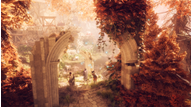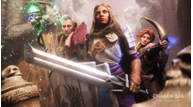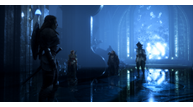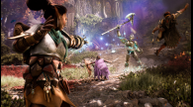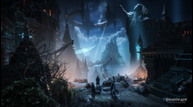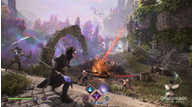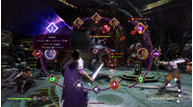
Dragon Age: The Veilguard has some deliciously deep RPG systems - hands-on preview
The pre-release period for Dragon Age: The Veilguard has been something of a rollercoaster. When we first saw it back in June, Adam came away impressed by the spectacle but remained skeptical as to the game’s role-playing gameplay credentials. A couple of days later, an impromptu chat with the director of this latest Thedas adventure helped to set our minds at ease, with talk of deep RPG progression systems, and inspirations rooted in things like Final Fantasy XII's License Board.
But the proof really is in the pudding. Now, having played around seven hours of Dragon Age: The Veilguard in pre-prepared saves at various points of story and character progression, I can report: fear not. This is a proper, full-fat RPG - even though it’s a game that’s draped heavy in the trappings of mainstream-focused action-adventure games.
The Veilguard is a game where you can feel this difficult and delicate push and pull in almost every aspect of its design. There’s a desire to be something that can have major mainstream appeal and please fans of action games - but also an absolute, steadfast intention to still maintain legitimate role-playing chops..
This could even be felt in the game’s preview event. The subsection of EA that manages the game’s publishing is mentioned to be the ‘Action-Adventure’ group. Arriving at the hotel that formed the event’s accommodation, signage pointing to a welcome mixer reads ‘DAV - Action Adventure Preview’. “I hope not,” one member of the media writes into a group chat designed to help present media to communicate. “I hope it is still an RPG.”
We’ve seen this sort of perilous balance many times before. The Veilguard’s most recent peer in this sense is probably Final Fantasy XVI, which channeled the likes of Devil May Cry and God of War 2018 while desperately fighting, to some extent in vain, to respect FF’s role-playing roots. But Dragon Age’s latest may well be the most successful of these games, appearing in this hands-on to deftly thread the needle, providing both exhilarating action and RPG chops.
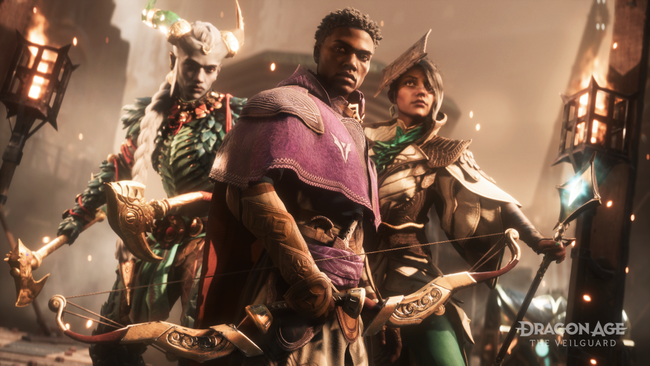
There’s a lot to talk about here, from structure to characters to art design - but we’re RPG Site, so let’s keep harping on the RPG stuff in specific first, yeah? Here’s the spiel.
In Dragon Age: The Veilguard, you’ll choose one of three character classes to define the combat style of Rook, your protagonist - Warrior, Mage, and Rogue. So far, so familiar. Each of these three classes has detailed, expansive skill trees that branch into a range of different directions, meaning that your version of exactly what a Mage is might differ significantly from mine.
Experimentation, foresight, and build-planning seem to have been at the forefront of the design. As seen in something like FF12’s License Board, which The Veilguard director Corinne Busch name-checked as an inspiration, you start at a specific point of these trees - specifically at the ‘core’, in the middle - and then work your way out. But everything is unlocked from the start, which means you can scroll around, looking at the late-build skills and abilities, allowing you to plan the path you’ll cut through these various upgrades and plan your build in detail.
Sadly we can’t show you a new static visual of these good-looking menus, as BioWare and EA have inexplicably not provided a single new or late-game screenshot of them, and we’re forbidden from taking screenshots of this type from captured video. But RPG aficionados will know this sort of system well - and once in game, there’s clever touches to both help the familiar and tutorialize for newcomers. Like how each grid is broken into sub-sections, like slices of a pizza - and each sub-section runs on a different theme. Allow us to break these down:
- Warrior class users will see their skill tree divided into Survival (defensive focus & stunning enemies), Mourn Watch (weaken enemies over time, plus shield tossing), Abilities (focused on battlefield spacing & other active abilities), Lord of Fortune (a reckless hit-and-run crit-driven style), Weapons (boosting attack chains & weapon techs), and Grey Warden (where defense is your offense).
- For the Rogue, the zones are Sustain (defensive abilities, counter attacks, and buff duration increases), Lord of Fortune (traps & exploiting enemies), Control (ranged abilities to puppeteer the flow of battle), Veil Jumper (bows and long-range combat buffs), Burst (heavy hitting abilities), and Antivan Crow (melee & parrying).
- Mage players can browse the skill tree subsections of Control (using ice magic to freeze and slow enemies), Shadow Dragon (controlling the battlefield space in other ways), Burst (fast-paced electrical elemental attacks), Ativan Crow (a more melee-like focus making use of a magical orb instead of a staff), Sustain (using fire to deal damage over time), and Mourn Watch (debuff enemies and damage them over time from great range).
You can obviously cut any path you like through the skill tree, and while there are set routes between skills so it isn’t entirely free-form, you’re set loose to mix and match these approaches as you feel. For the record, each class skill tree in total is, at a glance, over a hundred different discrete upgrades.
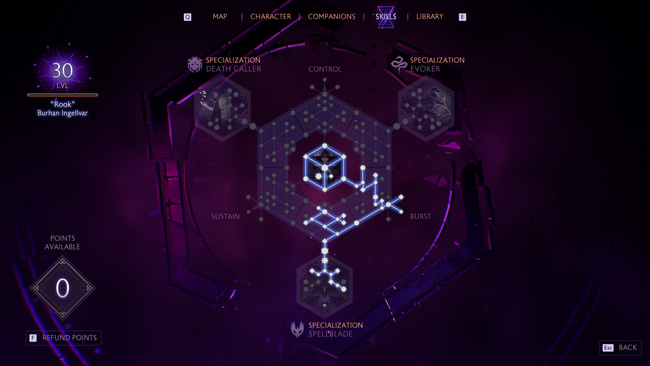
Once you choose a direction, each class also has three ‘Specializations’. These are mutually exclusive - so while you can invest skill points in skills from more than one, only one can be active at any given time. These basically give you the ultimate skills and buffs for three more prescribed play styles as designed by the team at BioWare, with each specialization home to as many as 14 additional skills. These are:
- Warrior Specializations are the Champion (Grey Warden combat, where you can rally allies and use your shield as a deadly weapon), the Reaper (who leeches life from enemies), or the Slayer (a raging bull that uses two-handed weapons to shatter enemy defenses).
- Rogue Specializations boil down as the Duelist (with a focus on fast-moving melee), the Saboteur (who, quelle surprise, lays traps), and the Veil Ranger (deadly with a bow).
- Mage Specializations are the Death Caller (sapping health from enemies to restore your own), the Evoker (the ultimate in battlefield control, plus powerful spells), and the Spellblade (a classic RPG mix of steel & sorcery).
The most exciting thing I can say about this hands-on experience is that once I started loading up saves from deeper in the game and seeing high-level characters, I could instantly see a joyous breadth of RPG possibilities stretch out before me. This is a respec-friendly game, putting the option to refund either one skill or even all skills right there in the menu - and it’s free of charge! You’re encouraged to experiment with your build - any time, anywhere.
As you’d expect, the various skills can interface with the equipment system, where the usual armor and accessory slots can be used to augment and synergize with your skills.
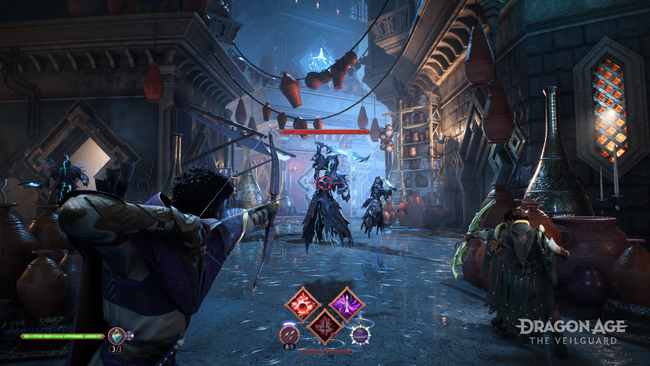
Here’s a great example: a Rogue has limited numbers of arrows that replenish slowly once you haven’t fired a shot in a while. But there also exists an item that gives Rogues a buff to do more melee damage the more arrows they have in their inventory. By default, the Rogue tops out at maybe five arrows - but various skills on the tree can give you more. A true system-breaking sicko might want to equip that item, then respec in the skill tree in a way that gives you twenty or more arrows - and then rain down the damage and crack certain encounters open like an egg. It’s exciting, and it's satisfying just to think about. If this sort of depth and balance-shattering nonsense is fully available, it'll be better still.
Most important, I suppose, is that you don’t have to do that. Like I say, The Veilguard is trying to thread the needle - somebody who wants to play this game more like a straight action-adventure will be able to muddle through the skill system easily enough. But the depth is there for us sickos, the sort of people who visit a website that is called, well, RPG Site.
All of this would only work if the combat itself is good. It is. There’s a snappy air of a character action game about it, though with that ever-present caveat that a role-playing game with companions and multiple classes is never going to quite feel as polished as one of those games. What’s there is good, though, meshing with lovely visuals to create encounters that pop.
The Mage and the Rogue are both astonishingly fun, and both manage to subvert and respect the traditions of those classes at the same time. The fact that from the drop the Mage has access to both a staff for traditional magic and a dagger for brutal melee assaults feels exciting. The Rogue feels brutal. If I have a criticism, it’s that these two classes sort of made the more traditional Warrior feel a touch boring - even though it too was engaging to play.
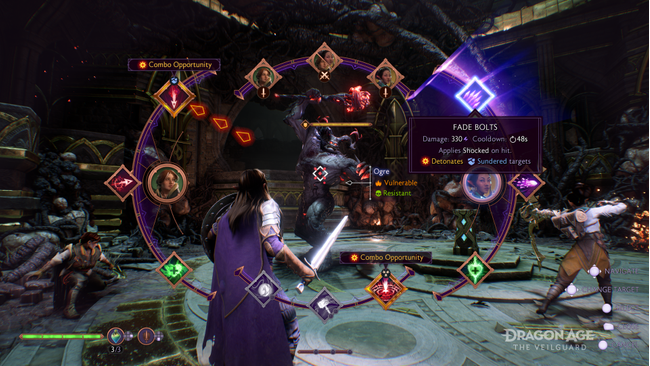
Everything just feels rather well-considered. There’s some small touches that serve to streamline but also scratch a nice RPG fan itch, like how you don’t have to juggle loads of duplicate loot. If you get a dupe of an item you already have, what it does instead is upgrade the rarity of the existing version of the item you have. That’s less time messing around selling useless loot, and more time examining the stats on the upgraded item to see how it might mesh with your build. None of this is exactly new or revolutionary in RPG terms, but it’s been way too long since I’ve seen a game with this sort of structure have this sort of depth of progression.
Structurally, Dragon Age: The Veilguard most closely resembles Mass Effect 2 and 3. It features that same cadence, mission structure, and feel. That’s no bad thing, though, considering those are some of BioWare’s best.
Companions have subtle skill progression, but nothing on the main character. They can be given rudimentary orders in combat, and choosing a pairing of companions whose abilities can combo to cause magical detonations and the like is key to combat success. The Lighthouse is the Veilguard’s Normandy equivalent - a hub from which the party hangs out, socializes, drops exposition, and launches into missions.
Mission zones basically take two forms. There’s linear stages where you’ll battle through enemies, enjoy the odd cutscene or set piece, and make dialogue choices and world-altering decisions that can branch the whole narrative. Additionally, there’s other hub zones - like towns or cities - which you’ll revisit multiple times and free-roam, sometimes for quests and combat but other times just for the hangoutitude. Again, this echoes the Citadel, or Omega. It feels very Mass Effect 2, and a world apart from the sprawling, over-sized MMO-esque zones of the last Dragon Age title.

The difference to Mass Effect 2 & 3, I suppose, is in the role-playing. The Mass Effect games were quite soft RPGs on the whole - they were action games with branching stories and excellent character relationships. That’s here in The Veilguard, too - I see strong examples of deep story branching, and I think this charismatic cast has a strong shot at being the best ensemble the Dragon Age franchise has ever produced. Naturally, much of this experience will hinge on the story delivery and how great one’s sense of narrative satisfaction is as the credits roll. That’s par for the course for a BioWare game. Nevertheless, it’s the game’s structure which has grabbed me.
Basically, this has the structure of a linear action-adventure game, but the progression timbre and ambition of a full-fat RPG. These two streams don’t quite cross in this way all that often - and the result has seized my attention.
Of course, even a confidently-presented, wide-reaching, all-day preview event is never quite enough to truly judge an RPG of this scale and scope. The final test will be with the final game. What can seem deep at first blush can be less so on closer examination - but for now, I am more than cautiously optimistic. I’m actually rather pumped. I look forward to trying to joyously break this game’s systems next month - my personal hype is now higher than it’s ever been.
Dragon Age: The Veilguard releases for PC, Xbox Series X/S, and PS5 on October 31. Travel and accomodation at the preview event were covered by EA.

